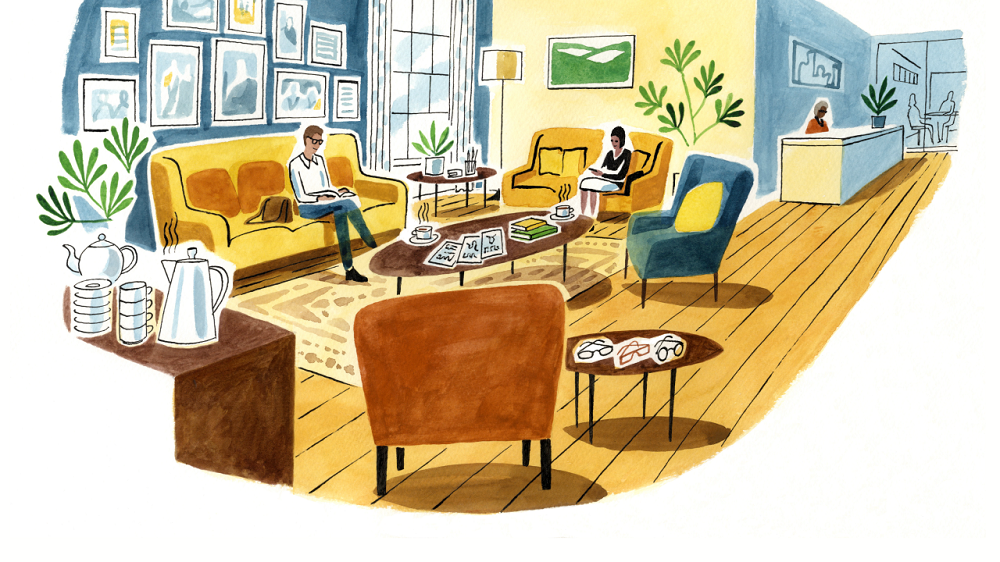Does how you design your office have an impact on your success?
Looking for a way to better connect and engage with clients? Consider updating your office décor and culture to reflect a more personal, “experience”-based attitude that highlights the rewards that come from smart investing—as well as the shared connections that exist between skilled financial professionals and successful clients.
Also worth considering: Making your workspace more homelike. "...there’s a growing desire to incorporate the feeling of home into the workplace..." With so many Americans making the transition from remote working to going back to the office over the past year or so, there’s a growing desire to incorporate the feeling of home into the workplace, according to WB Wood, a leading office furniture dealer with offices in New York and New Jersey.
“This year’s trends in office interior design will include softening the atmosphere with residential design elements, such as open shelving, framed artwork, mirrors, rugs, curtains, floor lamps, and coffee tables,” WB Wood said in its annual trend report, published in January. “Sofas, lounge chairs, softer lighting, and wood flooring can add warmth to a workplace and make it feel more homelike.”
Conversation starters
Even something as simple as adding the right mix of photos and collectibles to office walls and shelves is a huge first step in creating a welcoming environment for new and existing clients. This mix can include items relating to the professional’s own interests, such as sailing, guitars, or gardening, but it should also have room for photos of clients on vacation or enjoying their own hobbies.
Such touchstones provide an opportunity for conversation and establish common ground that may deepen client relationships and forge stronger bonds over time. Done well and combined with occasional out-of-the-office special events, they foster a more enjoyable client experience.
“Once you know your clients well enough, you can personalize every interaction and take the business relationship to an even deeper level that may lead to improved performance and business growth, along with better results for the client,” says Bill Sweeney, program director with Global Atlantic Consulting.
Are you experienced?
Global Atlantic’s research has found that experience-centric financial professionals have a client base with a median wealth of $1 million compared to $518,732 for professionals that take a more traditional, service-based approach, Sweeney says, adding that “levels of ‘involuntary attrition,’ in which a client chooses to change professionals, also are much lower with experience-based practices—a median rate of 24% versus 34% for traditional practices.”
Experience-based professionals also are much more likely to be referred to new clients, and their core market is more likely to be affluent.
“Emphasizing experience rather than service is a win-win for both parties: It can help you enhance the clients’ experience while also growing your business,” Sweeney says. “By creating more loyalty, you build strong advocates and relationship champions among your client bases and improve your bottom-line success.”
It’s the difference between a retailer like Toys “R” Us just selling one toy at a time, and Build-A-Bear, “which creates a rich, interactive in-store experience that brings parents and kids back again and again,” Sweeney says.
The celebration wall
One idea that Sweeney says is particularly effective—and easy to execute—is the “celebration wall.” Located in the greeting area/waiting room of an office, a celebration wall features a montage of photographs of successful clients enjoying their lives. Candid photos of clients and their families — hiking in the woods, relaxing at the beach, or spending time with friends —work best, since these are positive images that almost anyone can relate to and aspire to for their own lives.
"...building interiors such as offices can be more than functional—they also can have a positive impact on how people feel and relate to one another."
The wall makes an interesting setting for clients to study while waiting for a meeting, and it also provides an effective backdrop for Zoom sessions and other video conferencing.
“What we sell is so abstract,” says Sweeney. “When you buy an annuity, it could be years before you see the fruit of that seed that you planted. By showing a picture of a happy customer enjoying their retirement because of the investments they’ve made, you may make that abstract idea more concrete.”
Finding material for the wall involves asking select clients to share some photos of their favorite moments then framing and hanging them in a creative way. To underscore the theme of the rewards that come with hard work and savvy money management, testimonials from clients or inspirational messages that tie into the images also could be displayed. The goal is to help clients feel valued, at ease and confident in the services they will be receiving.
“A few choice quotes, either from famous people or clients themselves, really bring a celebration wall to life,” Sweeney says, adding that while the inspirational posters found in many professionals’ offices still have a place, “they’re starting to feel a little old school.”
A welcoming environment
Personalizing an office space is a great way to create a welcoming environment. In addition to wall art, there are a variety of other elements that may help clients relax. They include:
- Plants: Incorporating some greenery into an office not only enhances aesthetics but also improves air quality and creates a calming atmosphere.
- Mementos: Displaying a few personal items such as awards, diplomas, or photos from special work or family events provides a natural point of engagement with clients.
- Desk accessories: Stylish and functional desk accessories that match your personal style, such as a unique pen holder, decorative desk lamp, or colorful mouse pad add a fun touch and can be good conversation starters.
- Books and magazines: Create a small bookshelf or stack a few books and magazines on a table in the waiting area related to lifestyle topics, such as music, film, or architecture.
- Keep audio in mind: Don’t forget that a lot of clients may also struggle with their hearing. Arrange office seating in an intimate way that encourages easy conversation, and keep background sounds, including music, to a minimum.
- Refreshments: Offer a variety of complimentary beverages such as water, coffee, or tea. A few healthy snacks also are always appreciated.
- Digital access: Provide free and reliable Wi-Fi access for clients to use during their visits to your office. Display the network name and password in a visible location or provide it to clients upon their arrival.
- Television: A TV can be a good addition to an office’s waiting room space if it isn’t intrusive. Tune the set to a channel that features interesting, inoffensive content, such as a history, wildlife, or a home improvement program, or create a “slide show” of client photos in place of a celebration wall.
- Smart technologies: In addition to providing clients with convenient TV and Wi-Fi access, the use of smart technologies can “positively affect occupant wellbeing and contribute to more sustainable environments,” says the American Society of Interior Designers, a leading professional association for interior designers nationwide.
Moving beyond function
In its 2023 Trends Outlook report, ASID also highlights the growing role that neuroscience research is playing in the design of workplaces and homes. “Thanks to advancements in research tools and techniques, we know more about how the brain supports mental processes, including what happens when we encounter different environments,” the report states.
This new field of neuroaesthetics is still in the early stages but it is already providing insights into how workplaces may be designed to improve productivity and wellness. For example, it’s been known for some time that including curved shapes in furniture design can be emotionally comforting, and that incorporating plants and natural materials into interior spaces has a similar effect on both mental and physical health. Future research is likely to uncover additional insights, underscoring the idea that building interiors such as offices can be more than functional—they also can have a positive impact on how people feel and relate to one another.
Share
Related resources
More on Practice Management
Your Thriving
Practice
A destination to empower financial professionals to build, manage, and grow their practice
Get started with Global Atlantic
Take the next step with a company that can help elevate your business.
Need help?
Find all the contact information to submit and service your business.











